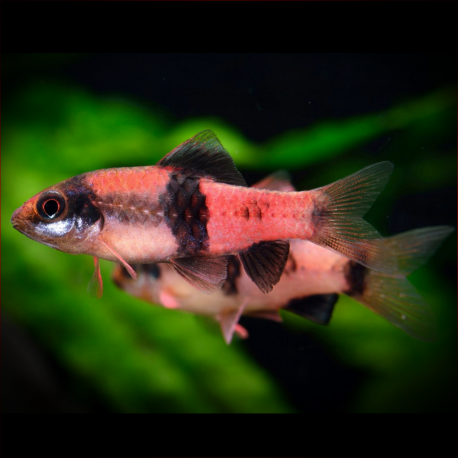More info
Datasheet
| Minimum Tank Size | 80 litres / 21.13 US gallons |
| Maximum Size | 7.0cm / 2.76inches |
| Temperature | 22°C / 71.60°F - 26°C / 78.80°F |
| Hardness | 2.02dgH / 36ppm - 10.03dgH / 179ppm |
| pH | 6.0-7.5 |
Behaviour:
The Melon Barb is generally very peaceful, making it an ideal resident for a community aquarium. However, due to its somewhat vigorous feeding nature, it may outcompete slower-moving or timid fishes. When kept in a community tank, it can coexist with popular fish species such as small cyprinids, tetras, livebearers, rainbowfishes, certain anabantoids, catfishes, and loaches. It is recommended to maintain a mixed-sex group of at least 8-10 specimens to observe natural behaviors, especially the fascinating interactions between rival males when competing for female attention or hierarchical dominance.
Feeding and Diet:
In the wild, Melon Barbs are omnivores, feeding on diatoms, algae, detritus, small insects, worms, crustaceans, and zooplankton. In the aquarium, they are easily-fed but thrive best on a diet consisting of small live and frozen foods like bloodworms, Daphnia, and Artemia, along with high-quality dried flakes and granules. It is advisable to include food with additional plant or algal content to ensure optimal health and coloration.
Reproduction:
Regarding reproduction, Melon Barbs are egg-scattering free spawners with no parental care. The species can spawn regularly in suitable conditions. To maximize breeding success, a controlled breeding tank should be set up, dimly lit, filled with mature water, and equipped with a mesh or spawning substrate. Females should be introduced when gravid, and spawning usually occurs the next morning. The fry should be fed infusoria-grade food initially and later transitioned to microworms or Artemia nauplii.
Dimorphism:
Dimorphically, female Melon Barbs tend to be larger and fuller-bodied, especially during breeding. Males, on the other hand, exhibit more vibrant colors, typically showcasing red and/or black pigmentation in the dorsal fin.
Habitat and Distribution:
Endemic to the Western Ghats mountains in the south Indian states of Goa, Karnataka, Kerala, and Tamil Nadu, the Melon Barb inhabits various habitats from hill streams to major rivers, irrigation canals, ponds, lakes, and ditches. They prefer shallow, quiet zones with submerged cover like aquatic vegetation or leaf litter. The species is often found in large schools alongside other small cyprinids and shows variable coloration and markings depending on geographical location and habitat type. Mixing different geographical variants in aquariums should be avoided to prevent hybridization.
Aquarium Setup:
For an optimal aquarium setup for Melon Barbs, it is essential to provide a well-maintained tank with subdued lighting and a dark substrate to enhance their colors. A planted tank with driftwood, roots, and floating vegetation can mimic their natural habitat. Including smooth rocks, aquatic plants like Lagenandra ovata and Blyxa aubertii, and leaf litter can further create a natural environment conducive to the species' well-being. Maintaining water conditions within the specified ranges of pH, temperature, and hardness is crucial for the health and vitality of the fish.

